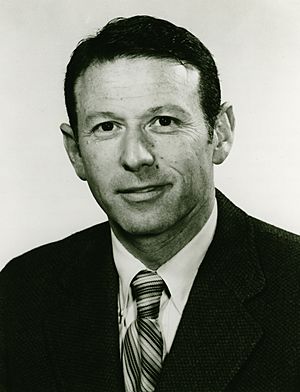Paul Berg facts for kids
Quick facts for kids
Paul Berg
|
|
|---|---|

Berg in 1980
|
|
| Born | June 30, 1926 New York City, U.S.
|
| Died | February 15, 2023 (aged 96) Stanford, California, U.S.
|
| Alma mater |
|
| Known for | Recombinant DNA |
| Spouse(s) |
Mildred Levy
(m. 1947) |
| Children | 1 |
| Awards |
|
| Scientific career | |
| Fields | Biochemistry |
| Institutions | |
Paul Berg (born June 30, 1926 – died February 15, 2023) was an American biochemist. He was a professor at Stanford University. In 1980, he won the Nobel Prize in Chemistry. He shared the award with Walter Gilbert and Frederick Sanger.
The Nobel Prize honored their important work with nucleic acids. Nucleic acids are like the building blocks of DNA. Berg studied at Pennsylvania State University and Case Western Reserve University. He also taught at Washington University School of Medicine.
Contents
Early Life and School
Paul Berg was born in Brooklyn, New York City. His parents were immigrants from Russia. He finished Abraham Lincoln High School in 1943.
He then went to Penn State University. There, he earned a degree in biochemistry in 1948. Later, he got his PhD in biochemistry from Case Western Reserve University in 1952.
Research and Career
Where Paul Berg Worked
After finishing his studies, Berg worked as a researcher for two years. He worked in Copenhagen, Denmark, and at Washington University School of Medicine. He also spent time at Clare Hall, Cambridge.
He was a professor at Washington University School of Medicine from 1955 to 1959. In 1959, Berg moved to Stanford University. He taught biochemistry there until 2000. He also led the Beckman Center for Molecular and Genetic Medicine. He stopped teaching and leading in 2000 but kept doing research.
What Paul Berg Studied
Paul Berg's early research used special "tracers." These tracers helped him understand how food turns into materials for cells. He used special carbon or nitrogen atoms to follow these processes.
Berg is most famous for his work with recombinant DNA. This is like taking DNA from two different species and putting them together. He was the first scientist to do this. This method was a huge step for modern genetic engineering. Genetic engineering is about changing an organism's genes.
After creating this method, Berg used it to study viruses. He also became interested in how science affects public rules. He helped organize the Asilomar conference on recombinant DNA in 1975. At this meeting, scientists talked about the possible risks of recombinant DNA research. They set rules to make sure this research was safe.
Awards and Honors

Nobel Prize in Chemistry
Paul Berg won half of the 1980 Nobel Prize in Chemistry. The other half was shared by Walter Gilbert and Frederick Sanger. Berg was honored for his "basic studies of the biochemistry of nucleic acids." This included his work with recombinant DNA. Sanger and Gilbert were honored for finding the order of bases in nucleic acids.
Other Important Awards
Berg received many other awards. In 1966, he became a member of the National Academy of Sciences. In 1983, he received the National Medal of Science. This is a very high honor for scientists in the United States. He also became a Foreign Member of the Royal Society in 1992. In 2005, he received the Biotechnology Heritage Award.
Death
Paul Berg passed away on February 15, 2023. He was 96 years old.
See also
 In Spanish: Paul Berg para niños
In Spanish: Paul Berg para niños

